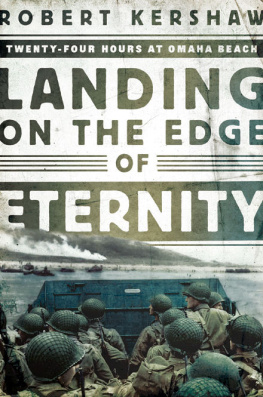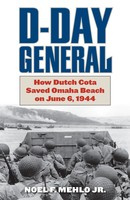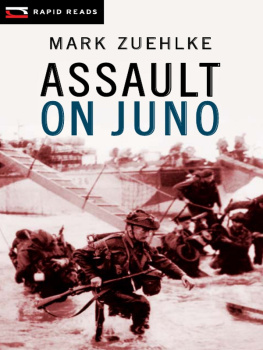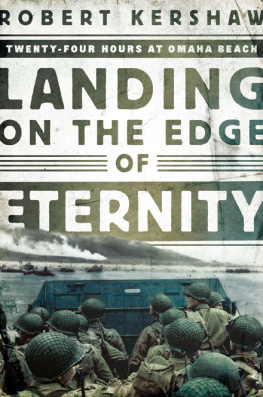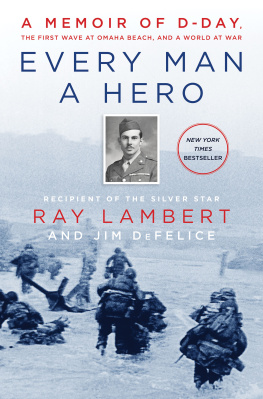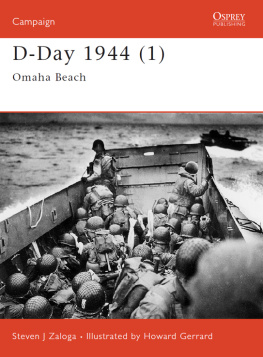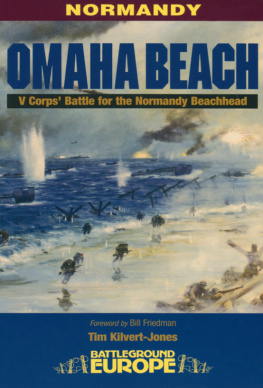LANDING
ON THE EDGE OF
ETERNITY
TWENTY-FOUR HOURS AT OMAHA BEACH
ROBERT KERSHAW

PEGASUS BOOKS
NEW YORK LONDON
This book is dedicated to my Father, Lesley Kershaw, Lgion dHonneur, who landed in the second wave on Gold Beach on DDay, and to my Mother, whom he met in Hamburg, 1945 .
CONTENTS


THE GERMANS
Oberleutnant Bernhard Frerking, commanding the 1st Battery of Artillery Regiment 352, had his forward artillery observation post located at strongpoint WN 62 at Colleville-sur-Mer. One of his soldiers claimed, he kept human feeling awake in me during an inhuman war.
Gefreiter Franz Gockel manned a water-cooled Polish machine gun at WN 62. He felt like God in France, but was surprised at the primitive state of the Atlantic Wall.
Oberstleutnant Ernst Goth commanded 916 Regiment, responsible for the forward sector of Omaha Beach. He was confident his men were well trained enough to give a good account of themselves.
Oberleutnant Hans Heinz was Goths Ordinance officer, a Stalingrad veteran who also had misgivings about the much-vaunted Atlantic Wall. A veteran Feldwebel had confided they could hold off successive waves of invaders, but once the ammunition ran out it would all be over.
Kurt Keller was a private in the reconnaissance unit of Fusilier Battalion 352. He was an ardent Nazi and disapproved of his NCOs amoral relationships with the local French women. He was convinced the invasion would not succeed, declaring, Where the German soldier stands, nobody gets through!
Machine Gunner Wilhelm Kirchhoff, with Werfer Regiment 84, occupied a cliff-edge trench near the observation bunker on top of Pointe du Hoc. Now were in for it, his officer had confided when they saw the massive invasion fleet.
Generalmajor Dietrich Kraiss was the astute Russian Front veteran commander of the 352nd Infantry Division. He had trained it up to crack status, far superior to the static infantry divisions positioned left and right of Omaha Beach. The Americans did not know his division was there.
Oberstleutnant Karl Meyer commanded Grenadier Regiment 915, which was Kraisss operational Kampfgruppe reserve. During the early hours of the D-Day morning it was sent off in the wrong direction to combat American paratroopers that had landed well to the west of Omaha Beach. It would prove difficult to turn back.
Unteroffizier Henrik Naube manned a machine gun at WN 73 on the cliffs overlooking the Vierville draw. He thought the prospect of the Allies invading Germany one day to be unimaginable.
Gefreiter Heinrich Severloh was Oberleutnant Frerkings aide and manned a machine gun at WN 62. Severloh did not fit into the Wehrmacht concept of blind obedience; he was an individual. His effectiveness behind the gun that day was to earn him the dubious title the Beast of Omaha.
Grenadier Karl Wegner manned a machine gun at beach level inside a bunker at WN 71 at Vierville-sur-Mer. After mistakenly declaring a fishing boat to be the invasion, he was nervously determined to conduct himself well. He could not believe the size of the fleet when it did appear.
Gefreiter Gustav Winter was the 75mm gunner inside a concrete panzer turret at WN 66, covering the beach at Saint-Laurent-sur-Mer at the center of Omaha Beach. He was an expanzer crewman, whose fingers and nose had been seriously damaged by frostbite in Russia. He was transferred to this lonely outpost with his loader, a young Czech-German boy, who was not very bright, but very enthusiastic.
Oberstleutnant Fritz Ziegelmann was chief of staff to General Kraiss, the cerebral foil to the astute and decisive practical general. Operational research had convinced him the invasion was on that night, and he had placed the division on alert. When American paratroopers landed in strength to the west, the division reserve was prematurely committed in the wrong direction.
THE FRENCH
Albert Andr was pressed by the Germans to work on the unfinished beach defenses in the center of Omaha Beach the previous afternoon, fitting a tank turret to WN 66. He did not think, with all the activity, that pressed labor would be required that day.
Michel Hardelay had to assist the Germans with the demolition of his own house at Vierville-sur-Mer to make room for beach defenses. His neighbor had ridiculed his attempts to build a family shelter trench, convinced the Allies would never land here. Hardelay was not so sure.
Suzanne Hardelay was a young child when the invasion came. The first thing she saw at Vierville was American legs striding past her basement.
Victorine Houyvet was a thirty-one-year-old schoolteacher living at Vierville. The first American she saw shot at her through the window while she was pulling her skirt on, hardly an auspicious introduction to the liberators.
Jean Marion, the French Underground chief at Grandcamp was aware the invasion was pending. Theres so many ships out there, he told his wife, theres no room for the fish.
Louise Oxant had set off with her ten-year-old son that morning on a donkey to milk her neighbors cows. The delayed bombing release for the approaching US air force Liberator armada intent on destroying the German defenses at Omaha would place her right in the eye of the storm.
Edmond Scelles was sixteen and lived at Saint-Laurent-sur-Mer. They had forty German soldiers billeted at their farm, and the alarm had been called. They moved out to occupy their beach positions seemingly totally confident.
THE AMERICANS
Private John Barnes was aboard LCA-911 with A Company the 116th Regiment heading toward Vierville off Omaha Beach. He had agreed to carry the heavy section flamethrower. Conditions were indescribable; everyone was seasick from the turbulence and they were constantly drenched by cold spray. The boat was alarmingly low in the water.
General Omar Bradley commanded the 1st US Army from aboard the cruiser USS Augusta ten miles offshore. He was concerned at the sea state, which would make his soldiers seasick and would compromise the launch of his DD tanks, vital to overcome the defending beach bunkers. Amazingly the Germans had not discovered their presence. He was frustrated and concerned he had no control of events onshore. Within three hours of landing he faced the dilemma whether or not to continue in the face of catastrophe.
Robert Capa was a celebrated combat war photographer working for Life magazine, who would land with E Company the 16th Regiment at Colleville, at the east side of Omaha Beach. He had chosen this hot spot because his maxim was, if the pictures are not good enough, then youre not close enough.
Brigadier General Norman Cota was the unassuming assistant 29th Division commander, who landed one hour after the first wave. He possessed the inspirational command steel to get men moving off the beach.
Captain Joe Dawson commanded G Company of the 16th Regiment, which managed to land as a cohesive company group and was the first to climb the bluffs near Colleville. They achieved a decisive penetration of the German defenses.
Private Sam Goodgal with Sergeant Raymond Crouch were paratroopers from the 101st (US) Airborne Division who were mis-dropped into the sea off Pointe du Hoc that night. They were already on the beach when Rudders Rangers landed and joined in the assault.
Lieutenant Coit Hendley was in command of LCI(L)-85, which approached the beach late in the morning opposite WN 62. At twenty-three he had enjoyed the carnival atmosphere in England prior to the invasion with his WREN girlfriend Sylvia, who worked with naval communications. She believed his ship had sunk; his father saw the listing wreck in newsreels of the invasion back home in the United States.
Next page
